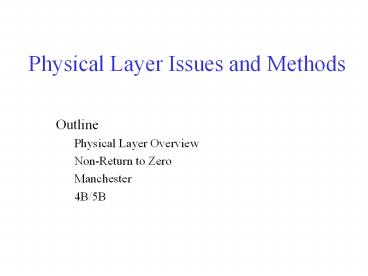Physical%20Layer%20Issues%20and%20Methods PowerPoint PPT Presentation
Title: Physical%20Layer%20Issues%20and%20Methods
1
Physical Layer Issues and Methods
- Outline
- Physical Layer Overview
- Non-Return to Zero
- Manchester
- 4B/5B
2
Physical Layer Data Transfer
- Signals are placed on wire via transceivers
- Problem is how to do transmit 0s and 1s (signal
encoding) in a robust fashion - Binary voltage encoding
- Map 1 to high voltage
- Map 0 to low voltage
- How are consecutive 0s or 1s detected at node?
- Clock synchronization problem
- Transmitted signals have a variety of problems
- Attenuation
- Noise
- Dispersion
3
Encoding Taxonomy
- Digital data, digital signal
- Codes which represent bits
- Our focus
- Many options!
- Analog data, digital signal
- Sampling to represent voltages
- Digital data, analog signal
- Modulation to represent bits
- Analog data, analog signal
- Modulation to represent voltages
4
Encoding Requirements
- Small bandwidth
- Enables more efficient use of signaling
capability - Low DC level
- Increases transmission distance
- Frequent changes in the voltage
- Enables synchronization between the transmitter
and the receiver without the addition of extra
signal - Non-polarized signal
- Enables use of 2-wire cable to not be affected by
the physical connection of the wires.
5
Non-Return to Zero (NRZ)
- High voltage 1 and low voltage 0
- Voltage does not return to 0 between bits
- Receiver keeps average of signal seen to
distinguish 0 from 1
6
NRZ
- Benefits
- Easy to engineer most basic encoding
- Efficient use of bandwidth not many transitions
- Drawbacks
- Long strings of 0s can be confused with no
signal - Long strings of 1s can cause signal average to
wander - Clock synchronization can be poor
- High DC average of ½V
7
NRZ-Inverted (NRZI)
- NRZI addresses clock synchronization problem
- Encodes 1 by transitioning from current signal
- Encodes 0 by staying at current signal
- So were still out of luck on consecutive strings
of 0s
8
Manchester Data Encoding
- Explicit merging of clock and bit stream
- Each bit contains a transition
- High-low 1
- Low-high 0
- Enables effective clock signal recovery at
receiver - Clocks are still needed to differentiate between
bit boundaries - Poor bandwidth utilization
- Effective sending rate is cut in half
- Used by 802.3 10Mbps Ethernet
9
Manchester Encoding contd.
V
V
-V
-V
Encoding for 1
Encoding for 0
1
1
1
1
0
0
0
0
0
V
-V
Bit Boundaries
Signal Edges
10
4B/5B Encoding
- Tries to address inefficiencies in Manchester
- Idea is to insert extra bits in bit stream to
break up long sequences of 0s or 1s - Every 4 bits of data are encoded in a 5 bit code
- Encodings selections
- At most one leading 0
- At most two trailing 0s
- Never more than three consecutive 0s
- Uses NRZI to put bits on the wire
- This is why code is focused on zeros
- 80 efficiency
- See text for details of codes

